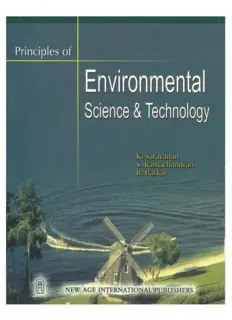Table Of ContentPrinciples of
Environmental
Science & Technology
This page
intentionally left
blank
Principles of
Environmental
Science & Technology
Or. K. Saravanan
prof. S. Ramachandran
R. Baskar
-.~
NEW AGE INTERNATIONAL (P) liMITED, PUBUSHERS
New Delhi . B.n",lorc . Ch.nn.; • Cochin • Guw.h ..i • Hy<I ......d
J.J.ndh. . . Kolka •• • Lu.kn_ . Momb.i • Ron<hi
Copyright © 2005, New Age International (P) Ltd., Publishers
Published by New Age International (P) Ltd., Publishers
All rights reserved.
No part of this ebook may be reproduced in any form, by photostat, microfilm,
xerography, or any other means, or incorporated into any information retrieval
system, electronic or mechanical, without the written permission of the publisher.
All inquiries should be emailed to [email protected]
ISBN (13) : 978-81-224-2341-9
PUBLISHING FOR ONE WORLD
NEW AGE INTERNATIONAL (P) LIMITED, PUBLISHERS
4835/24, Ansari Road, Daryaganj, New Delhi - 110002
Visit us at www.newagepublishers.com
PREFACE
This book is meant to be an introductory text on the Fundamentals of Environmental Science
and Engineering. Today, knowledge of Environmental Science is essential for students as well
as practicing engineers and scientists of all disciplines. Here an attempt has been made to
provide precise and upta date infoIlllation on the fundamental aspects of Environmental Science
and Engineering without going much in-depth in to specific areas, so as to be useful for a
cross section of fields of study. Indian technical universities are making the study of
Environmental Science and Engineering mandatory for all courses and hence a 'comprehensive
textbook covering all domains of this field (including the policy aspects and management
practices) is the need of the hour.
The book adopts a simple narrative style keeping in mind both the knowledge requirements
and the examination needs of university students. The authors wish to profusely thank all those
who have supported them in their effort viz. the Management, the Principal, teachers, professors
and students of our institution Kongu Engineering College, Perundurai, Erode. The authors also
thank Mis New Age International (P) Ltd. for having accepted to publish the work and the
wonderful way they have brought out this book in such a short time.
Feedback and corrective action is the only way to progress. As students of science the
authors most humbly seek feed back from the readers of this book. The authors can be reached
in any of the following e~ mail addresses -
sar_ [email protected],[email protected], [email protected]
-Authon
This page
intentionally left
blank
CONTENTS
Prefaee eY)
Introduction 1
1 Components and Subcomponents of Environment 3
2. Science of Environment 33
3. Cum:nt Environmental Issues 50
4. Engineering Interventions to Reduce Environmental Stresses 61
5. Waste Minimization and Clean Technology 104
6. Environment and Development lIS
7. Tools for Environmental Management 139
8. Environmental Perfonnance Standards 173
Review Questions 186
Selected Bibliography 193
This page
intentionally left
blank
INTRODUCTION
The objective of this book is to promote an understating among Engineers of different disci
plines the concept and principles of environmental science and Engineering. Earth is a member of
the solar system orbiting the Sun. The Sun is one ofthe millions ofstars in the Milky Way. When the
Earth was formed there was no life in it. Mixtures of methane, ammonia, water vapour and hydrogen
wefe converted into life generating compounds by electrical discharge. Thus life came in to the
Earth. With the passage of time the evolution of life and Ecosystems took place. The planet as we
see today is the result of millions of years of evolution. The modem man with. his high level of
intellect became the most dominant animal in the entire planet.
SOME FACTS ABOUT THE EARTH
The earth is the third planet from the Sun at a distance of about 150 million kilometers, which is called
an "astronomic unit", The earth is 12760 kilometers in diameter. It is not an ideal globe. At the
equator there are little bumps and at the poles it is flatter than it is at the rest of the world. The
southern part has more bumps than the northern part. The Earth's circumference is 40070 kilometers.
Some basic facts about our planet is dli:tailed below:
Average Diameter 12760kms
Average Circumference 40070kms
Surface Area 510Million sq.kms
Land Area 149 Million sq.kms (29.2%)
Ocean Area 361 Million sq.kms (70.8 %)
Mass 5973 trillion tons
Human Population AroWld 7 Billion
Average surface temperature 14.3 deg C
Age 4.6 billion years
The surface temperatures on OUT planet fluctuate between -88 degrees Celsius (in Siberia)
and + 58 degrees Celsius (in Death Va1ley. California, USA). The temperature in the Earth's core is
about 10000-12000 degrees Celsius at a pressure ofabaut 3 millions times our air pressure at sea
level. About 70% of the Earth's surface consists of the ocean's water and hence Earth is called
"the blue planet". The oceans contain about 97% of all the water on our planet. The oceans have
high salt content. The Earth is the only planet in our solar system that has an atmosphere consisting

